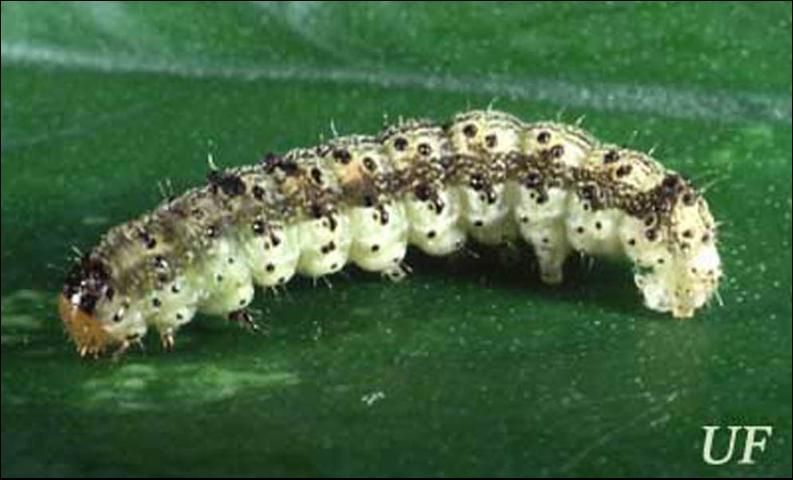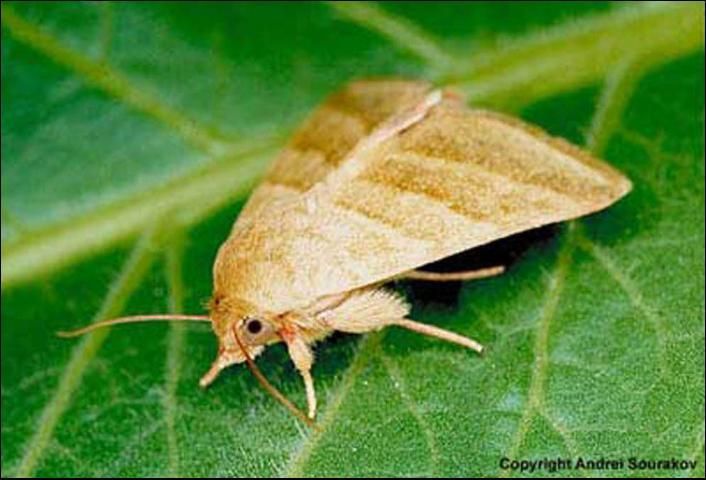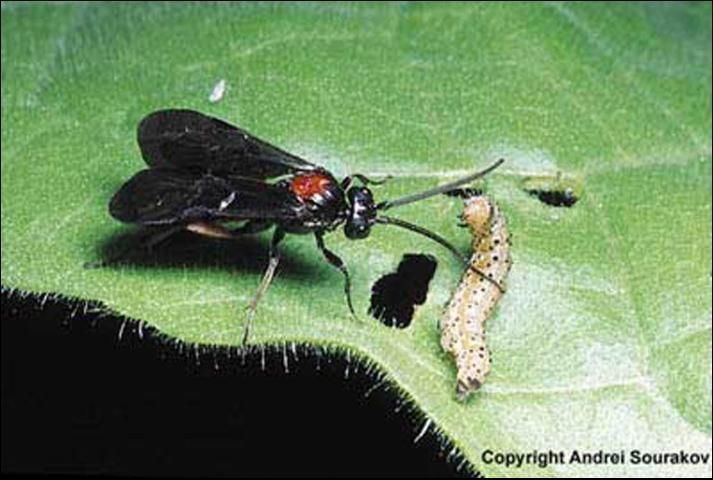The Featured Creatures collection provides in-depth profiles of insects, nematodes, arachnids and other organisms relevant to Florida. These profiles are intended for the use of interested laypersons with some knowledge of biology as well as academic audiences.
Distribution
The tobacco budworm, Heliothis virescens (Fabricius), is a native species and is found throughout the eastern and southwestern United States, though it is also known from California. It generally overwinters successfully only in southern states. However, it occasionally survives cold climates in greenhouses and other sheltered locations. Tobacco budworm disperses northward annually, and can be found in New England, New York, and southern Canada during the late summer. It also occurs widely in the Caribbean, and sporadically in Central and South America.

Credit: Andrei Sourakov, Florida Museum of Natural History
Life Cycle and Description
Moths emerge March through May in southern states, followed by four to five generations through the summer, with overwintering commencing September through November. Four generations have been reported from northern Florida and North Carolina, and at least five from Louisiana. Moths have been collected in New York July through September, but at such northern latitudes it is not considered to be a pest. This species overwinters in the pupal stage.
Eggs
Eggs are deposited on blossoms, fruit, and terminal growth. The eggs are spherical with a flattened base. They measure 0.51 to 0.60 mm (2 mm = 1/16 in) in width and 0.50 to 0.61 mm in height. Eggs initially are whitish to yellowish white in color but turn gray as they age. Narrow ridges radiate from the tip of the egg and number from 18 to 25. Eggs of tobacco budworm are nearly indistinguishable from those of corn earworm, Heliocoverpa zea. At high magnification, however, the primary ribs of tobacco budworm eggs can be observed to terminate before they reach the rosette of cells surrounding the micropyle; in corn earworm at least some primary ribs extend to the rosette. Females normally produce from 300 to 500 eggs, but 1000 to 1500 eggs per female have been reported from larvae cultured on artificial diet at cool temperatures.
Larvae
Tobacco budworm larvae have five to seven instars, with five or six most common. Head capsule widths for larvae that develop through five instars measure 0.26–0.31, 0.46–0.54, 0.92–0.99, 1.55–1.72, 2.38–2.87 mm for instars one through five, respectively. Larval lengths are 1.1–4.0, 4.2–8.0, 8.7–14.7, 18.5–25.6, and 23.3–35.6 mm for these same instars. Head capsule widths for larvae that develop through six instars measure 0.26–0.31, 0.36–0.53, 0.72–0.85, 1.12–1.25, 1.60–1.72, and 2.40–2.82 mm for instars one through six, respectively. Larval lengths are 1.4–4.1, 3.0–7.0, 7.5–9.2, 12.0–15.8, 19.5–24.3, and 25.5–36.0 mm for these same instars.
Development time was studied by Fye and McAda (1972) at various temperatures. When cultured at 20°C (68°F), development required about 4.6, 2.6, 3.1, 3.7, 10.1, and 9.8 days for instars one through six, respectively. At 25°C (77°F), larval development times were 3.1, 2.0, 1.9, 2.1, 5.7, and 2.5 days, respectively.
Young larvae are yellowish or yellowish green in color with a yellowish-brown head capsule. Later instars are greenish with dorsal and lateral whitish bands and a brown head capsule. Many of the bands may be narrow or incomplete, but a broad, lateral subspiracular band is usually pronounced. Body color is variable, and pale green or pinkish forms, or dark reddish or maroon forms are sometimes found. Larvae are very similar to corn earworm. As is the case with corn earworm, the body bears numerous black thorn-like microspines. These spines give the body a rough feel when touched.

Credit: John Capinera, UF/IFAS
Early instars are difficult to separate from corn earworm; Neunzig (1964) gives distinguishing characteristics. Starting with the third instar, close examination reveals tubercles with small thorn-like microspines on the first, second, and eighth abdominal segments that are about half the height of the tubercles. In corn earworm the microspines on the tubercles are absent or up to one-fourth the height of the tubercle. Larvae exhibit cannibalistic behavior starting with the third or fourth instar but are not as aggressive as corn earworm.

Credit:
Pupa
Pupation occurs in the soil. Pupae are shiny reddish brown in color, becoming dark brown prior to emergence of the adult. The pupa averages 18.2 mm in length and 4.7 mm in width. Duration of the pupal stage is reported to be about 22 days at 20°C (68°F), 13.0 days at 25°C (77°F), and 11.2 days at 30°C (86°F). Diapause is initiated by either low temperatures or short day length.
Adults
The moths are brownish in color and lightly tinged with green. The front wings are crossed transversely by three dark bands, each of which is often accompanied by a whitish or cream-colored border. Females tend to be darker in color. The hind wings are whitish, with the distal margin bearing a dark band. The moths measure 28 to 35 mm in wing span. The pre-oviposition period of females is about two days in length. Longevity of moths is reported to range from 25 days when held at 20°C (68°F) to 15 days at 30°C (86°F). A sex pheromone has been identified (Tumlinson et al. 1975).

Credit: Andrei Sourakov, Florida Museum of Natural History
Biology of tobacco budworm is given by Neunzig (1969) and Brazzel et al. (1953). The larva is included in keys by Okumura (1962) and Oliver and Chapin (1981); the latter publication also pictures the adult stage.
Host Plants
Tobacco budworm is principally a field crop pest, attacking such crops as alfalfa, clover, cotton, flax, soybean, and tobacco. However, it sometimes attacks such vegetables as cabbage, cantaloupe, lettuce, pea, pepper, pigeon pea, squash, and tomato, especially when cotton or other favored crops are abundant. Tobacco budworm is a common pest of geranium and other flower crops such as ageratum, bird of paradise, chrysanthemum, gardenia, geranium, mallow, marigold, petunia, snapdragon, strawflower, verbena, and zinnia.
Weeds serving as a host for larvae include beardtongue, Penstemon laevigatus; beggarweed, Desmodium spp.; bicolor lespedeza, Lespedeza bicolor; black medic, Medicago lupulina; cranesbill, Geranium dissectum; deergrass, Rhexia spp.; dock, Rumex spp.; groundcherry, Physalis spp.; Japanese honeysuckle, Lonicera japonica; lupine, Lupinus spp.; morning glory, Ipomoea spp.; a morning glory, Jacquemontia tamnifolia; passionflower, Passiflora sp.; prickly sida, Sida spinosa; sunflower, Helianthus spp.; toadflax, Linaria canadensis; and velvetleaf, Abutilon theophrasti. In Georgia, the tobacco budworm develops principally on toadflax during April and May for one to two generations, followed by one generation on deergrass during June and July and two to three generations on beggarweed during July through October. In Mississippi, cranesbill was identified as the key early season host plant. In southern Texas, cotton is the principal host, but such weeds as wild tobacco, Nicotania repanda; vervain, Verbena neomexicana; ruellia, Ruellia runyonii; and mallow, Aubitilon trisulcatum, are important hosts early or late in the year.
In cage tests and field studies conducted in Florida and that did not include cotton, tobacco was more highly preferred than other field crops and vegetables, but cabbage, collards, okra, and tomato were attacked (Martin et al. 1976).
Damage
Larvae bore into buds and blossoms (the basis for the common name of this insect), and sometimes the tender terminal foliar growth, leaf petioles, and stalks. In the absence of reproductive tissue, larvae feed readily on foliar tissue. Neunzig (1969) infested tobacco with both tobacco budworm and corn earworm and observed very similar patterns and levels of injury by these closely related species. Entry of larvae into fruit increases frequency of plant disease. Research in southern Arkansas tomato fields indicated that although tobacco budworm was present from May through July, they were not nearly as abundant or damaging as corn earworm (Roltsch and Mayse 1984).
Natural Enemies
Numerous general predators have been observed to feed upon tobacco budworm. Among the most common are Polistes spp. wasps (Hymenoptera: Vespidae); bigeye bug, Geocoris punctipes (Say) (Hemiptera: Lygaeidae); damsel bugs, Nabis spp. (Hemiptera: Nabidae); minute pirate bugs, Orius spp. (Hemiptera: Anthocoridae); and spiders.
Several parasitoids also have been observed, and high levels of parasitism have been reported. The egg parasitoid Trichogramma pretiosum Riley (Hymenoptera: Trichogrammatidae) can be effective in vegetable crops. Other important parasitoids are Cardiochiles nigriceps Viereck in vegetables and Cotesia marginiventris (Cresson) in other crops (both Hymenoptera: Braconidae). Effectiveness of the parasitoids varies among crops. Other species known from tobacco budworm include Archytas marmoratus (Townsend) (Diptera: Tachinidae); Meteorus autographae Muesebeck (Hymenoptera: Braconidae); Campoletis flavicincta (Ashmead), Campoletis perdistinctus (Viereck), Campoletis sonorensis (Cameron), Netelia sayi (Cushman) and Pristomerus spinator (Fabricius) (all Hymenoptera: Ichneumonidae).

Credit: Andrei Sourakov, Florida Museum of Natural History

Credit: Andrei Sourakov, Florida Museum of Natural History
Pathogens also are known to inflict mortality. Among the known pathogens are microsporidia, Nosema spp., fungi such as Spicaria rileyi, and nuclear polyhedrosis viruses. In a study conducted in South Carolina, Spicaria fungus was a more important mortality agent than natural incidence of virus, and was considered to be one of the most important natural mortality agents.
Management
Sampling
Large cone-shaped wire traps baited with sex pheromone lures are commonly used to capture tobacco budworm moths. Smaller bucket traps can capture these moths, but they are not very efficient.
Insecticides
Foliar insecticides are commonly used in crops where tobacco budworm damage is likely to occur. However, destruction of beneficial organisms often results, and this is thought to exacerbate budworm damage. Also, resistance to insecticides is widespread, particularly in crops where pyrethroid use is frequent.
Cultural Techniques
Early season destruction of weeds with herbicide or mowing, or destruction of larvae on the weeds by treatment with insecticides, can reduce tobacco budworm population size later in the year.
Biological Control
The microbial insecticide Bacillus thuringiensis is effective against budworm. Heliothis nuclear polyhedrosis virus has been used effectively to suppress tobacco budworm on field crops and on early season weed hosts. Tobacco budworm also is susceptible to nuclear polyhedrosis virus from alfalfa looper, Autographa californica (Speyer). Release of Trichogramma egg parasitoids has been shown to be beneficial in some vegetable crops (Martin et al. 1976).
Host Plant Resistance
Although there is little evidence for natural resistance to tobacco budworm among many crops, cotton is being genetically engineered to express resistance. Enhanced resistance to larval survival by cotton should result in lower insect pressure on nearby vegetable crops.
Selected References
Brazzel, J.R., L.D. Newsom, J.S. Roussel, C. Lincoln, F.J. Williams, and G. Barnes. 1953. "Bollworm and tobacco budworm as cotton pests in Louisiana and Arkansas." Louisiana Agric. Exp. Stn. Tech. Bull. 482. 47 pp.
Fye, R.E. and W.C. McAda. 1972. "Laboratory studies on the development, longevity, and fecundity of six lepidopterous pests of cotton in Arizona." USDA Tech. Bull. 1454. 73 pp.
Martin, P.B., P.D. Lingren, and G.L. Greene. 1976. "Relative abundance and host preferences of cabbage looper, soybean looper, tobacco budworm, and corn earworm on crops grown in northern Florida." Environ. Entomol. 5:878–882. https://doi.org/10.1093/ee/5.5.878
Martin, P.B., P.D. Lingren, G.L. Greene, and R.L. Ridgway. 1976. "Parasitization of two species of Plusiinae and Heliothis spp. after releases of Trichogramma pretiosum in seven crops." Environ. Entomol. 5:991–995. https://doi.org/10.1093/ee/5.5.991
Neunzig, H.H. 1964. "The eggs and early-instar larvae of Heliothis zea and Heliothis virescens (Lepidoptera: Noctuidae)." Ann. Entomol. Soc. Am. 57:98–102. https://doi.org/10.1093/aesa/57.1.98
Neunzig, H.H. 1969. "The biology of the tobacco budworm and the corn earworm in North Carolina with particular reference to tobacco as a host." North Carolina Agric. Exp. Stn. Tech. Bull. 196. 76 pp.
Okumura, G.T. 1962. "Identification of lepidopterous larvae attacking cotton with illustrated key (primarily California species)." California Dept. Agric. Bur. Entomol. Spec. Publ. 282. 80 pp.
Oliver, A.D. and J.B. Chapin. 1981. "Biology and illustrated key for the identification of twenty species of economically important noctuid pests." Louisiana Agric. Exp. Stn. Bull. 733. 26 pp.
Roltsch, W.J. and M.A. Mayse. 1984. "Population studies of Heliothis spp. (Lepidoptera: Noctuidae) on tomato and corn in southeast Arkansas." Environ. Entomol. 13:292–299. https://doi.org/10.1093/ee/13.1.292
Tumlinson, J.H., D.E. Hendricks, E.R. Mitchell, R.E. Doolittle, and M.M. Brennan. 1975. "Isolation, identification and synthesis of the sex pheromone of the tobacco budworm." J. Chem. Ecol. 1:203–214. https://doi.org/10.1007/BF00987869